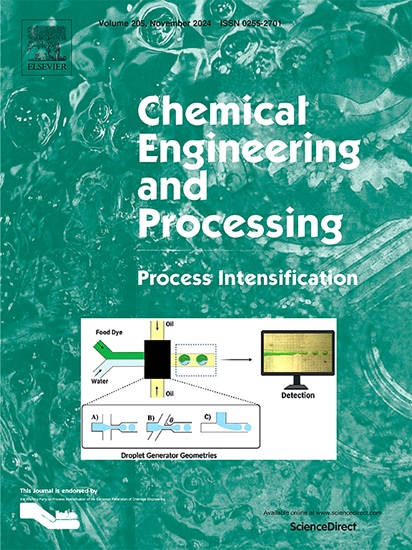用微波法提取富多酚茶叶冲剂合成多功能TPP-Co3O4 NPs,增强其生物医学应用
IF 3.9
3区 工程技术
Q3 ENERGY & FUELS
Chemical Engineering and Processing - Process Intensification
Pub Date : 2025-04-26
DOI:10.1016/j.cep.2025.110329
引用次数: 0
摘要
绿茶因其健康益处而广为人知,它是多酚的宝贵来源,可用于各种生理活动。采用微波辅助提取绿茶中多酚的高效方法。利用响应面法(RSM)优化提取参数,制备了一种富含多酚的茶叶冲剂,用于合成TPP-Co3O4 NPs。为了考察微波强度(A)、温度(B)、时间(C)和溶剂/茶比(D)等不同因素的影响,我们进行了单因素实验。我们采用四因素、三水平Box-Behnken设计(BBD)的RSM来优化TPC收率。TPC含量的最佳条件为:A = 600 W, B = 75℃,C = 400 sec, D = 30 mL/g,得到TPC含量为51.21 mg GAE/g茶。利用富多酚茶叶冲剂制备氧化钴纳米颗粒(TPP-Co3O4 NPs)。采用多种物理化学技术对合成的纳米颗粒进行了研究。TPP-Co3O4 NPs对革兰氏阳性金黄色葡萄球菌(S. aureaus)和革兰氏阴性大肠杆菌(Escherichia coli)表现出有效的抑制潜力。此外,TPP-Co₃O₄NPs表现出显著的抗氧化潜力,DPPH自由基减少了88%。TPP-Co3O4 NPs的巨大表面积和可忽略不计的大小可以解释这些显著的生物活性。本文章由计算机程序翻译,如有差异,请以英文原文为准。

An Eco-benign synthesis of multifunctional TPP-Co3O4 NPs by polyphenol rich tea infusion extracted by microwave method with enhanced biomedical applications
Green tea is widely known for its health benefits and is a valuable source of polyphenols that can be used for various physiological activities. A highly effective method involving microwave assistance was employed for polyphenol extraction from green tea leaves. The response surface methodology (RSM) enhanced the extraction parameters to produce a polyphenol-rich tea infusion to synthesize TPP-Co3O4 NPs. To look into the effect of different factors such as MW intensity (A), temperature (B), time (C), and solvent/tea ratio (D), we conducted single-factor experiments. We applied RSM using a four-factor, three-level Box-Behnken design (BBD) to optimize TPC yield. The optimal conditions for TPC contents were as follows: A = 600 W, B = 75 °C, C = 400 sec, and D = 30 mL/g, resulting in TPC contents of 51.21 mg GAE/g tea. The polyphenol-rich tea infusion was subjected to prepare cobalt oxide nanoparticles (TPP-Co3O4 NPs). Several physicochemical techniques were used to investigate the synthesized nanoparticles. TPP-Co3O4 NPs exhibited effective inhibition potential against gram positive Staphylococus aureaus (S. aureaus) and gram negative Escherchia coli (Escherichia coli) bacteria. Furthermore, TPP-Co₃O₄ NPs exhibited significant antioxidant potential, achieving an 88 % reduction in DPPH free radicals. TPP-Co3O4 NPs' enormous surface area and negligible size could explain these remarkable biological activities.
求助全文
通过发布文献求助,成功后即可免费获取论文全文。
去求助
来源期刊
CiteScore
7.80
自引率
9.30%
发文量
408
审稿时长
49 days
期刊介绍:
Chemical Engineering and Processing: Process Intensification is intended for practicing researchers in industry and academia, working in the field of Process Engineering and related to the subject of Process Intensification.Articles published in the Journal demonstrate how novel discoveries, developments and theories in the field of Process Engineering and in particular Process Intensification may be used for analysis and design of innovative equipment and processing methods with substantially improved sustainability, efficiency and environmental performance.

 求助内容:
求助内容: 应助结果提醒方式:
应助结果提醒方式:


